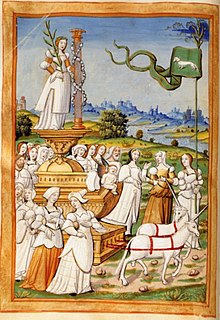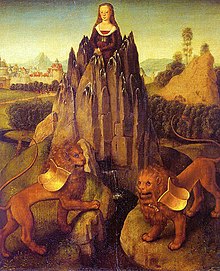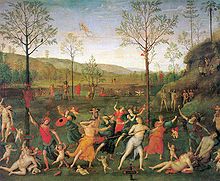chastity
Chastity ( chaste from the Latin conscius , 'conscious'), Latin castitas is an ethical concept of moderation in dealing with sexuality , mostly for religious reasons.
Often, chastity is understood to mean only sexual abstinence or celibacy; The ideal of willful and conscious chastity is more far-reaching: Chastity describes the behavior of a person to behave in a shameful manner on the basis of an acquired sense of shame or by virtue of a conscious principle and to avoid the indecent and violations of morality . In many cultures, the demand for chastity plays a role as a religious commandment ( see also taboo ). This understanding of chastity as general moderation, which is not limited to sexual behavior alone, can also be observed in the development of the word chaste in German. In Middle High German , kiusche still meant “demure” or “conscious”. It was only towards New High German that the meaning narrowed towards sexual abstinence.
In Christian iconography , the seven deadly sins are often contrasted with the seven heavenly virtues ; chastity as a virtue is the counterpart of lust ( Latin luxuria ). This assignment can already be found in the Psychomachia . In medieval theology and accordingly in European art history, unchastity or lasciviousness is the counterpart to chastity and represents one of the central seven vices from which sins arise and which are therefore also called "root sins".
In Christian iconography , the lily is a symbol of virgin purity.
Chastity in religions
Christianity
In the history of Christianity, chastity is seen as an acquired, moral virtue of man. Thomas Aquinas discussed this theological issue under the theme of "infused virtues". Martin Luther describes chastity as the main virtue of the gospel .
The Christianity understands chastity preservation of the eyes, ears and thoughts of things that violate the natural or acquired modesty. This also includes the conscious renunciation of sexual acts in the case of unmarried persons and in the case of married couples the renunciation of sexual acts outside of marriage. Chastity is derived as a Christian virtue and moral requirement from the 6th commandment ("You shall not commit adultery", Ex 20.14 EU ) and the words of the Apostle Paul , who called the body a "temple of the Holy Spirit" ( 1 Cor 6,19 EU ). Chastity is also one of the fruits of the Holy Spirit ( Gal 5:22 EU ). The virtue of chastity is also derived from the cardinal virtue of moderation.
According to the apostle Paul, Christian marriage is a useful community for people who cannot withstand the sexual urge (1 Cor 7: 8–9). The Roman Catholic Church coined the term conjugal chastity here . Promiscuity and adultery are rejected by all Christian churches. Premarital intercourse or partnership of unmarried people is tolerated by some churches today, but viewed as a deviation from the ideal of marriage.
When spouses, according to a mutual will and for reasons of faith, refrain from consummating the marriage, this is called a Joseph marriage . The term is derived from Joseph of Nazareth , who, according to church tradition and Catholic and Orthodox doctrinal views, led such a marriage with the Virgin Mary .
Roman Catholic Church

The Roman Catholic Church does not equate chastity with sexual abstinence:
“[Chastity] should distinguish people in the various stages of life: some in the state of virginity or consecrated celibacy, an excellent way of giving oneself more easily to God alone with an undivided heart; the others, in the manner determined for everyone by the moral law, depending on whether they are married or unmarried. "
The Church Father Ambrose of Milan writes:
“There are three forms of the virtue of chastity: one is that of the married, the other that of the widowed, and the third that of virginity. We do not praise one to the exclusion of the other. This is what makes the discipline of the Church so rich. "
The sexuality embedded in the relationship and mutual devotion of spouses is not unchastity, but even desirable.
The obligation to live a celibate life with the celibacy of the clergy and in the forms of consecrated life according to the evangelical counsels (promise of virginity or celibacy for the sake of the kingdom of heaven through public vows ) are not only about renouncing marriage, sexual acts and to surrender to sexual fantasies (chastity of thoughts), but ultimately to a personal freedom in which one's own libido is integrated into an inner unity of the mature personality.
Evangelical Movement
The youth movement True Love Waits , which emerged in evangelical circles in the United States in the early 1990s , advocates abstinence until marriage . From this an international movement developed, which is also active in the German-speaking area under the name Wahre Liebe Wartet (see also chastity movement ).
Islam
An important statement of the Koran can be found in Sura 17 : 32: "And do not approach adultery ..." In addition, Islam recommends avoiding any unnecessary contact between the sexes. Men are asked to lower their eyes ( Sura 24:30 ). They should behave as chastely as women ( Sura 33 : 35).
Lifelong abstinence is rejected in Islam because (according to a hadith ) marriage is half faith and the Koran rejects monasticism ( Sura 57 : 27).
In many Islamic societies, the headscarf (or the veil ) is a symbol of chastity. The bare hair is perceived in many societies as a sensual attraction or as a main component of a woman's beauty. "By covering her beauty, which lies above all in her hair, she wants to make it known that she is not interested in flirting and does not want to have relationships with strange men in which sexuality plays a role." ( Hadayatullah Hübsch )
Chastity in japan
In the Japanese culture, male chastity is referred to as a dōtei and was particularly respected in the pre-war period.
See also
- youth
- Dōtei
- Drive renunciation
- Bridal veil
- Lucretia
- Susanna in the bath
- Chastity belt
- Monk's pepper , also called chaste tree
literature
- Albrecht Diem: The Monastic Experiment. The role of chastity in the emergence of Western monasticism . LIT-Verlag, Münster 2005 (Vita Regularis, Abhandlungen, Volume 24).
- Benedict J. Groeschel: The Courage to be Chaste. Paulist Press, New York 1985, ISBN 0-8091-2705-9 .
- Johann August Eberhard : Synonymic concise dictionary of the German language . 1910, No. 183, textlog.de
- Anton Kner: What sustains us in life. The virtues of the Christian in everyday life . Selected and edited by Reinhard Abeln. Kanisius, Freiburg (Switzerland) 1994, ISBN 3-85764-408-7 .
- Dominikus Mettenleiter : Of St. Thomas Aquinas Himmelsleiter, or exercise of the most excellent virtues. Georg-Joseph-Manz-Verlag, Regensburg 1854.
- Josef Müller: The ideas of chastity in their historical development and practical significance . F. Kirchheim, Mainz 1897, archive.org .
Web links
Individual evidence
- ^ F. Bross: Basic course in German linguistics for the Bavarian state examination . Gunter Narr, Tübingen 2014, p. 174.
- ^ Ambrosius, vid. 23
- ↑ Tertullian, De exhortatione castitatis (On the invitation to chastity)
- ↑ The divine virtues of faith, hope and love are therefore not reduced to the moral (personal) being of man like a higher level of moral virtues, but underpin and embrace the moral virtues, shape them and exaggerate them. The virtues of celibacy, chastity, virginity, fasting, humility , self- humility and simplicity, infused in faith, reveal what the virtue of moderation, discipline and discipline is . Compare also Albert Zimmermann (Ed.): Thomas von Aquin. Work and effect in the light of recent research . in the Google book search de Gruyter 1988.
- ↑ D. Martin Luther's Gospel Interpretation, Gospel of Mark and Luke, Part 3
- ^ Catechism of the Catholic Church , No. 2341
- ^ Catechism of the Catholic Church , No. 2349
- ↑ cf. Pope Pius XI, encyclical Casti connubii , “On Christian Marriage”, 1930
- ^ Catechism of the Catholic Church KKK 2349
- ^ Catechism of the Catholic Church, III.2.2.Art.6, Vocation to Chastity . intratext.com
- ^ Josemaría Escrivá de Balaguer: Meeting Christ: Homilies . 6th edition. unchangeable Reprinted in Cologne 2006, ISBN 3-925746-64-1
- ^ Compendium on the Catechism of the Catholic Church. Libreria Editrice Vaticana, 2005. Announcement. radiovaticana.org, June 28, 2005
- ↑ Article. ( Memento from February 9, 2009 in the Internet Archive ) Kopftuch.info

